HP (Hewlett-Packard) M1005 MFP User Manual
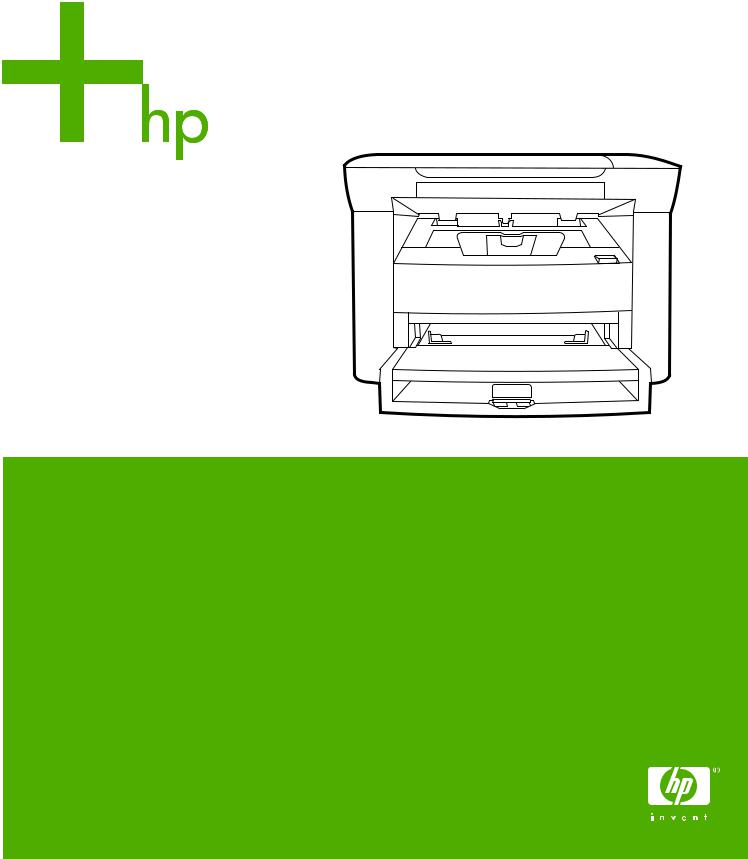
HP LaserJet M1005 MFP
User Guide

HP LaserJet M1005 MFP
User Guide

Copyright and License
© 2006 Copyright Hewlett-Packard
Development Company, LP
Reproduction, adaptation, or translation without prior written permission is prohibited, except as allowed under the copyright laws.
The information contained in this document is subject to change without notice.
The only warranties for HP products and services are set forth in the express warranty statements accompanying such products and services. Nothing herein should be construed as constituting an additional warranty. HP shall not be liable for technical or editorial errors or omissions contained herein.
Part number CB376-90911
Edition 1, 8/2006
Trademark Credits
Adobe® and PostScript® are trademarks of Adobe Systems Incorporated.
Linux is a U.S. registered trademark of Linus Torvalds.
Microsoft®, Windows®, and Windows® XP are U.S. registered trademarks of Microsoft Corporation.
UNIX® is a registered trademark of The Open Group.
ENERGY STAR® and the ENERGY STAR mark® are U.S. registered marks of the United States Environmental Protection Agency.
Table of contents
1 Device basics |
|
Device features ...................................................................................................................................... |
2 |
Device parts ........................................................................................................................................... |
3 |
Front view .............................................................................................................................. |
3 |
Back view .............................................................................................................................. |
3 |
Control panel ......................................................................................................................... |
4 |
2 Software |
|
Minimum system requirements .............................................................................................................. |
6 |
Supported operating systems ................................................................................................................ |
6 |
Software installation .............................................................................................................................. |
7 |
Printer driver .......................................................................................................................................... |
8 |
Printer-driver Help ................................................................................................................. |
8 |
Changing printer-driver settings ............................................................................................ |
9 |
Software for Windows .......................................................................................................................... |
10 |
HP LaserJet Scan software ................................................................................................ |
10 |
Installing Windows device software .................................................................................... |
10 |
Uninstalling Windows device software ............................................................................... |
10 |
Software for Macintosh ........................................................................................................................ |
11 |
Installing Macintosh device software .................................................................................. |
11 |
Uninstalling Macintosh device software .............................................................................. |
11 |
3 Media specifications |
|
General guidelines ............................................................................................................................... |
14 |
Choosing paper and other media ........................................................................................................ |
14 |
HP media ............................................................................................................................ |
14 |
Media to avoid ..................................................................................................................... |
14 |
Media that can damage the device ..................................................................................... |
15 |
Guidelines for using media .................................................................................................................. |
16 |
Paper ................................................................................................................................... |
16 |
Colored paper ..................................................................................................................... |
17 |
Custom-size media ............................................................................................................. |
17 |
Labels .................................................................................................................................. |
17 |
Label construction .............................................................................................. |
17 |
Transparencies ................................................................................................................... |
17 |
Envelopes ........................................................................................................................... |
18 |
Envelope construction ........................................................................................ |
18 |
Envelopes with double-side seams .................................................................... |
18 |
Envelopes with adhesive strips or flaps ............................................................. |
19 |
ENWW |
iii |
Envelope storage ............................................................................................... |
19 |
Card stock and heavy media .............................................................................................. |
19 |
Card stock construction ...................................................................................... |
19 |
Card stock guidelines ......................................................................................... |
19 |
Letterhead and preprinted forms ........................................................................................ |
20 |
Supported media weights and sizes .................................................................................................... |
21 |
Printing and storage environment ....................................................................................................... |
23 |
4 Using the device |
|
Loading media ..................................................................................................................................... |
26 |
Loading documents to copy or scan ................................................................................... |
26 |
Loading input trays .............................................................................................................. |
26 |
Priority input tray ................................................................................................ |
26 |
Main input tray (tray 1) ....................................................................................... |
27 |
Controlling print jobs ............................................................................................................................ |
28 |
Print-settings priorities ........................................................................................................ |
28 |
Selecting a source .............................................................................................................. |
28 |
Selecting a type or size ....................................................................................................... |
28 |
Using the device control panel ............................................................................................................ |
29 |
Changing the control-panel display language .................................................................... |
29 |
Changing the default media size and type ......................................................................... |
29 |
To change the default media size ...................................................................... |
29 |
To change the default media type ...................................................................... |
30 |
5 Printing |
|
Using features in the Windows printer driver ...................................................................................... |
32 |
Creating and using quick sets ............................................................................................. |
32 |
Creating and using watermarks .......................................................................................... |
33 |
Resizing documents ............................................................................................................ |
33 |
Setting a custom paper size from the printer driver ............................................................ |
34 |
Using different paper and printing covers ........................................................................... |
34 |
Printing a blank first page or last page ............................................................................... |
34 |
Printing multiple pages on one sheet of paper ................................................................... |
34 |
Printing on both sides ......................................................................................................... |
35 |
Using features in the Macintosh printer driver ..................................................................................... |
37 |
Creating and using presets ................................................................................................. |
37 |
Printing a cover page (Macintosh) ...................................................................................... |
38 |
Printing multiple pages on one sheet of paper (Macintosh) ............................................... |
38 |
Printing on both sides (Macintosh) ..................................................................................... |
39 |
Printing on special media .................................................................................................................... |
41 |
Using archive print ............................................................................................................................... |
41 |
Canceling a print job ............................................................................................................................ |
42 |
6 Copy |
|
Starting a copy job ............................................................................................................................... |
44 |
Canceling a copy job ........................................................................................................................... |
44 |
Adjusting the copy quality .................................................................................................................... |
44 |
Adjusting the lighter/darker (contrast) setting ...................................................................................... |
46 |
Reducing or enlarging copies .............................................................................................................. |
47 |
iv |
ENWW |
Adjusting the copy size ....................................................................................................... |
47 |
Copying multiple pages on one sheet of paper .................................................................. |
48 |
Changing the number of copies .......................................................................................................... |
49 |
Copying onto media of different types and sizes ................................................................................ |
50 |
Copying two-sided documents ............................................................................................................ |
52 |
Copying photos and books .................................................................................................................. |
54 |
Viewing copy settings .......................................................................................................................... |
55 |
7 Scan |
|
Understanding scanning methods ....................................................................................................... |
58 |
Scanning by using HP LaserJet Scan (Windows) ............................................................................... |
59 |
Canceling a scan job ........................................................................................................................... |
59 |
Scanning by using other software ....................................................................................................... |
60 |
Using TWAIN-compliant and WIA-compliant software ....................................................... |
60 |
Scanning from a TWAIN-enabled program ........................................................ |
60 |
To scan from a TWAIN-enabled program ......................................... |
60 |
Scanning from a WIA-enabled program (Windows XP or |
|
Windows Server 2003) ....................................................................................... |
60 |
To scan from a WIA-enabled program .............................................. |
60 |
Scanning a photo or a book ................................................................................................................. |
61 |
Scanning by using optical character recognition (OCR) software ....................................................... |
62 |
Readiris ............................................................................................................................... |
62 |
Scanner resolution and color ............................................................................................................... |
63 |
Resolution and color guidelines .......................................................................................... |
64 |
Resolution .......................................................................................................... |
64 |
Color ................................................................................................................... |
64 |
8 Managing and maintaining the device |
|
Information pages ................................................................................................................................ |
66 |
Managing supplies ............................................................................................................................... |
67 |
Checking supplies status .................................................................................................... |
67 |
Storing supplies .................................................................................................................. |
67 |
Replacing and recycling supplies ....................................................................................... |
67 |
HP policy on non-HP supplies ............................................................................................ |
67 |
HP fraud hotline .................................................................................................................. |
67 |
Cleaning the device ............................................................................................................................. |
69 |
To clean the exterior ........................................................................................................... |
69 |
To clean the scanner glass ................................................................................................. |
69 |
To clean the lid backing ...................................................................................................... |
69 |
To clean the paper path ...................................................................................................... |
70 |
Changing the print cartridge ................................................................................................................ |
71 |
9 Problem solving |
|
Problem-solving checklist .................................................................................................................... |
74 |
Clearing jams ....................................................................................................................................... |
76 |
Causes of jams ................................................................................................................... |
76 |
Tips to avoid jams ............................................................................................................... |
76 |
Where to look for jams ........................................................................................................ |
77 |
Input trays ........................................................................................................................... |
78 |
ENWW |
v |
Output bin ........................................................................................................................... |
80 |
Print-cartridge area ............................................................................................................. |
80 |
Control-panel messages ...................................................................................................................... |
82 |
Alert and warning messages .............................................................................................. |
82 |
Alert and warning message tables ..................................................................... |
82 |
Critical error messages ....................................................................................................... |
83 |
Critical error message tables ............................................................................. |
83 |
Print problems ...................................................................................................................................... |
85 |
Print quality problems ......................................................................................................... |
85 |
Improving print quality ........................................................................................ |
85 |
Understanding print-quality settings .................................................. |
85 |
To temporarily change print-quality settings ..................... |
85 |
To change print-quality settings for all future jobs ............ |
85 |
Identifying and correcting print defects .............................................................. |
86 |
Print-quality checklist ......................................................................... |
86 |
General print-quality issues ............................................................... |
86 |
Media-handling problems ................................................................................................... |
90 |
Print-media guidelines ........................................................................................ |
90 |
Solving print-media problems ............................................................................ |
91 |
Performance problems ....................................................................................................... |
92 |
Copy problems ..................................................................................................................................... |
93 |
Preventing problems ........................................................................................................... |
93 |
Image problems .................................................................................................................. |
93 |
Media-handling problems ................................................................................................... |
94 |
Performance problems ....................................................................................................... |
96 |
Scan problems ..................................................................................................................................... |
97 |
Solving scanned-image problems ...................................................................................... |
97 |
Scan-quality problems ........................................................................................................ |
98 |
Preventing problems .......................................................................................... |
98 |
Solving scan-quality problems ........................................................................... |
98 |
Control-panel display problems ........................................................................................................... |
99 |
Solving common Macintosh problems ............................................................................................... |
100 |
Problems with Mac OS X V10.3 and Mac OS X V10.4 .................................................... |
100 |
Problem-solving tools ........................................................................................................................ |
102 |
Restoring the factory-set defaults ..................................................................................... |
102 |
Reducing paper curl .......................................................................................................... |
102 |
Appendix A Accessories and ordering information |
|
Supplies ............................................................................................................................................. |
104 |
Cable and interface accessories ....................................................................................................... |
104 |
User-replaceable parts ...................................................................................................................... |
104 |
Paper and other print media .............................................................................................................. |
104 |
Appendix B Service and support |
|
Hewlett-Packard limited warranty statement ..................................................................................... |
108 |
Print Cartridge Limited Warranty Statement ..................................................................................... |
109 |
Availability of support and service ..................................................................................................... |
110 |
HP Customer Care ............................................................................................................................ |
110 |
Hardware service ............................................................................................................................... |
111 |
Extended warranty ............................................................................................................................. |
111 |
vi |
ENWW |
Guidelines for repacking the device .................................................................................................. |
112 |
Appendix C Device specifications |
|
Physical specifications ....................................................................................................................... |
114 |
Electrical specifications ..................................................................................................................... |
114 |
Power consumption ........................................................................................................................... |
114 |
Environmental specifications ............................................................................................................. |
114 |
Acoustic emissions ............................................................................................................................ |
115 |
Appendix D Regulatory information |
|
FCC compliance ................................................................................................................................ |
118 |
Environmental Product Stewardship program ................................................................................... |
118 |
Protecting the environment ............................................................................................... |
118 |
Ozone production .............................................................................................................. |
118 |
Power consumption .......................................................................................................... |
118 |
HP LaserJet printing supplies ........................................................................................... |
120 |
Disposal of waste equipment by users in private household in the European Union ...... |
121 |
Material safety data sheet ................................................................................................. |
121 |
For more information ........................................................................................................ |
121 |
Declaration of conformity ................................................................................................................... |
122 |
Country-/region-specific safety statements ....................................................................................... |
123 |
Laser safety statement ..................................................................................................... |
123 |
Canadian DOC statement ................................................................................................. |
123 |
Korean EMI statement ...................................................................................................... |
123 |
Finnish laser statement ..................................................................................................... |
124 |
Glossary ............................................................................................................................................................ |
125 |
Index .................................................................................................................................................................. |
127 |
ENWW |
vii |
viii |
ENWW |
1 Device basics
●Device features
●Device parts
ENWW |
1 |

Device features
● Prints letter-size pages at speeds up to 15 pages per minute (ppm) and A4-size pages |
|
|
at speeds up to 14 ppm |
|
● Prints at 600 dots per inch (dpi) and FastRes 1200 dpi |
|
● Includes adjustable settings to optimize print quality |
|
● Average yield for the standard black print cartridge is 2000 pages in accordance with |
|
ISO/IEC 19752. Actual yield depends on specific use. |
|
|
Copy |
● Copies at 600 dots per inch (dpi) |
|
For more information, see Copy. |
|
|
Memory |
● Includes 32-megabyte (MB) random-access memory (RAM) |
|
|
Paper handling |
● Priority input tray holds up to 10 pages |
|
● Tray 1 holds up to 150 sheets of print media or 10 envelopes |
|
● Output bin holds up to 100 sheets of print media |
|
|
Scan |
● Provides 1200 pixels per inch (ppi) full-color scanning |
|
For more information, see Scan. |
|
|
Printer driver features |
● FastRes 1200 produces 1200-dots-per-inch (dpi) print quality for fast, high-quality |
|
printing of business text and graphics |
|
|
Interface connections |
● Includes a Hi-Speed USB 2.0 port |
|
|
Environmental features |
● ENERGY STAR®-qualified |
|
|
Economical printing |
● Provides N-up printing (printing more than one page on a sheet). See Printing multiple |
|
pages on one sheet of paper or Printing multiple pages on one sheet of paper |
|
(Macintosh). |
|
● Provides an EconoMode setting, which uses less toner |
|
|
Supplies |
● Uses a print cartridge that has a no-shake design |
|
|
Accessibility |
● Online user guide is compatible with text screen-readers. |
|
● Print cartridges can be installed and removed by using one hand. |
|
● All doors and covers can be opened by using one hand. |
|
|
|
|
2 Chapter 1 Device basics |
ENWW |
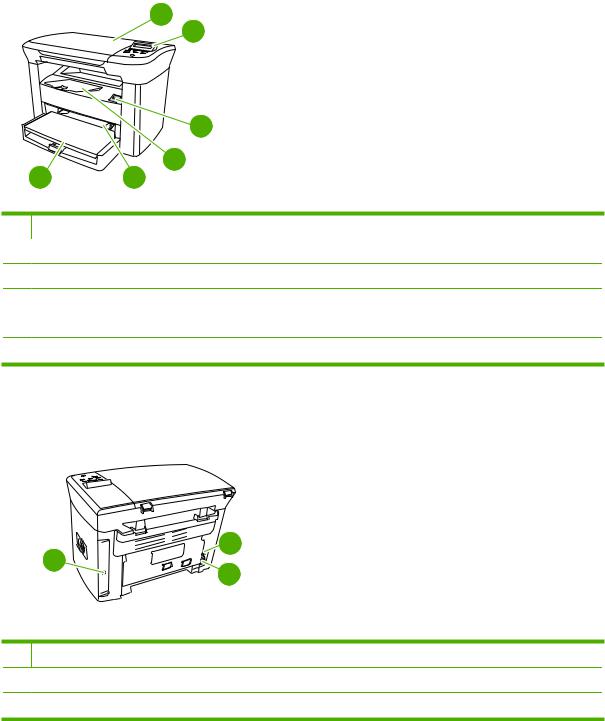
Device parts
Before using the HP LaserJet M1005, familiarize yourself with the parts of the device.
Front view
1
2
3
4
6 5
1Flatbed scanner cover
2 Control panel
Control panel
3 Cartridge-door release
Cartridge-door release
4 Output bin
Output bin
5 Priority input tray
Priority input tray
6 Tray 1
Tray 1
Back view
8
7
9
7Hi-Speed USB 2.0 port
8 Power switch
Power switch
9 Power receptacle
Power receptacle
ENWW |
Device parts 3 |

Control panel
|
1 |
2 |
3 |
|
|
|
|
4 |
|
|
|
|
5 |
|
|
|
|
6 |
|
|
|
|
7 |
|
|
|
|
8 |
|
|
|
|
9 |
|
|
|
|
|
|
|
|
|
|
|
1 |
Control-panel display |
|
● |
Shows status information, menus, and error messages |
2 |
Left arrow button |
|
● |
Navigates to the previous item in the list, or decreases the value of numeric |
|
|
|
|
items. With some numeric items, pressing the button once decreases the |
|
|
|
|
value by 1, while pressing and holding the button decreases the value by 10. |
3 |
Menu/Enter/OK button |
● |
Activates the control-panel menus |
|
|
|
|
● |
Clears an error condition when the condition is clearable |
|
|
|
● |
Saves the selected value for an item |
|
|
|
● |
Performs the action that is associated with the item that is highlighted on the |
|
|
|
|
control-panel display |
4 |
Right arrow button |
|
● |
Navigates to the next item in the list, or increases the value of numeric |
|
|
|
|
items. With some numeric items, pressing the button once increases the |
|
|
|
|
value by 1, while pressing and holding the button increases the value by 10. |
5 |
Cancel button |
|
● |
Cancels the current print, copy, or scan job in process and expels all of the |
|
|
|
|
active pages from the paper path. The time that it takes to cancel the job |
|
|
|
|
depends on the size of the print job. (Press the button only once.) Also |
|
|
|
|
clears continuable errors that are associated with the canceled job. |
|
|
|
● |
Exits the control-panel menus |
6 |
More Copy Settings button |
● |
Provides access to copy settings for the current copy job |
|
7 |
Lighter/Darker button |
|
● |
Provides access to copy contrast settings for the current copy job |
8 |
# Copies button |
|
● |
Provides a way to change the number of copies printed for a the current |
|
|
|
|
copy job |
9 |
Start Copy button |
|
● |
Starts a copy job |
|
|
|
|
|
4 Chapter 1 Device basics |
ENWW |
2 Software
●Minimum system requirements
●Supported operating systems
●Software installation
●Printer driver
●Software for Windows
●Software for Macintosh
ENWW |
5 |
Minimum system requirements
In order to install and use the device software, your computer must meet the following minimum requirements:
Windows requirements
●Pentium II (233 MHz) processor
●64 MB of RAM
●35 MB of disk space
●SVGA 800x600 16-bit color monitor
Macintosh requirements
●G3, G4, or G5 PowerPC processor
●128 MB of RAM
●30 to 50 MB of disk space
Supported operating systems
The device comes with software for the following operating systems:
●Windows XP
●Windows 2000
●Windows Server 2003
●Mac OS X V10.3 and later
6 Chapter 2 Software |
ENWW |
Software installation
If the computer meets the recommended minimum requirements, the installation process includes the following software.
●HP LaserJet Scan software program and driver
●Readiris OCR (not installed with other software; separate installation is required)
●Printer drivers (Windows and Mac)
●TWAIN driver (Mac)
ENWW |
Software installation 7 |
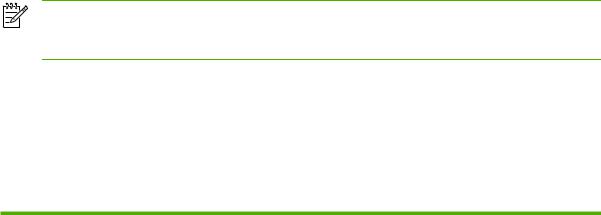
Printer driver
The device comes with software for Windows and Macintosh that allows the computer to communicate with the device. This software is called a printer driver. Printer drivers provide access to device features, such as printing on custom-sized paper, resizing documents, and inserting watermarks.
NOTE The most recent drivers are available at www.hp.com. Depending on the configuration of Windows-based computers, the installation program for the product software automatically checks the computer for Internet access in order to obtain the latest drivers.
Printer-driver Help
Printer-driver Help is separate from program Help. The printer-driver help provides explanations for the buttons, check boxes, and drop-down lists that are in the printer driver. It also includes instructions for performing common printing tasks, such as printing on both sides, printing multiple pages on one sheet, and printing the first page or covers on different paper.
Activate the printer-driver Help screens in one of the following ways:
Windows |
Macintosh |
|
|
● In the printer driver Properties dialog box, click the |
In the Print dialog box, click the ? button. |
Help button. |
|
● Press the F1 key on the computer keyboard. |
|
● Click the question-mark symbol in the upper-right |
|
corner of the printer driver. |
|
● Right-click on any item in the driver, and then click |
|
What's This?. |
|
|
|
8 Chapter 2 Software |
ENWW |
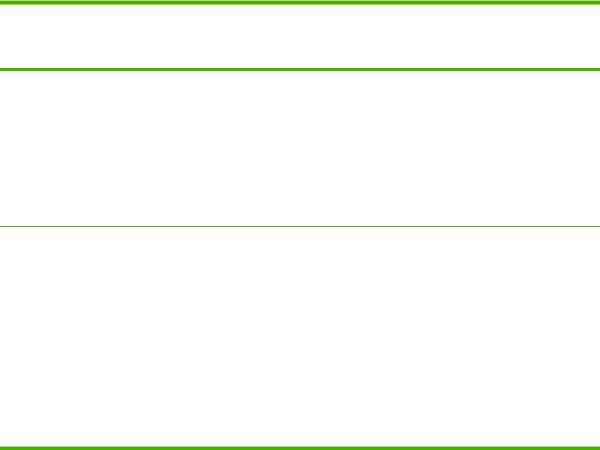
Changing printer-driver settings
Use one of the following methods to open the printer drivers from the computer in order to change settings:
Operating System To change the settings for all print jobs until the software program is closed
To change the print job default settings (for example, select a specific media type or size by default)
To change the configuration settings (for example, enable or disable manual duplexing)
Windows 2000, XP, 1. |
On the File menu in the |
and Server 2003 |
software program, click |
|
Print. |
2. |
Select the name of the |
|
printer, and then click |
|
Properties or |
|
Preferences. |
The steps can vary; this procedure is most common.
1.Click Start, click Settings, 1. Click Start, click Settings,
and then click Printers or |
and then click Printers or |
Printers and Faxes. |
Printers and Faxes. |
2. Right-click the printer icon, 2. |
Right-click the printer icon, |
and then select Printing |
and then select Properties. |
Preferences. |
|
3. |
Click the Device Settings |
|
tab. |
Mac OS X V10.3 1. On the File menu, click and Print.
Mac OS X V10.4
2.Change the settings that you want on the various pop-up menus.
1.On the File menu, click
Print.
2.Change the settings that you want on the various pop-up menus.
3.On the Presets pop-up menu, click Save as and type a name for the preset.
These settings are saved in the Presets menu. To use the new settings, you must select the saved preset option every time you open a program and print.
1.Open Printer Setup Utility by selecting the hard drive, clicking
Applications, clicking
Utilities, then doubleclicking Printer Setup Utility.
2.Click on the print queue.
3.On the Printers menu, click Show Info.
4.Click the Installable Options menu.
ENWW |
Printer driver 9 |

Software for Windows
See the getting started guide for installation instructions, and see the Readme file for the latest software information.
HP LaserJet Scan software
The software CD includes the HP LaserJet Scan software. See the Readme file that is provided on the CD for additional included software and for supported languages.
Installing Windows device software
Insert the software CD that came with the printer into the computer CD-ROM drive. Follow the onscreen installation instructions.
NOTE If the Welcome screen does not open, click Start on the Windows task bar, click Run, type Z:\setup (where Z is your CD drive letter), and click OK.
Uninstalling Windows device software
1.Click Start, and then click All Programs.
2.Click HP, and then click HP LaserJet M1005 MFP.
3.Click Uninstall HP LaserJet M1005 MFP, and then follow the onscreen instructions to remove the software.
10 Chapter 2 Software |
ENWW |
Software for Macintosh
This section describes how to install Macintosh printing system software.
Installing Macintosh device software
1.Connect a USB cable between the USB port on the printer and the USB port on the computer. Use a standard 2-meter (6.56-foot) USB cable.
2.Insert the printer CD into the CD-ROM drive and run the installer.
The Printer Setup Utility should automatically launch. If it does not launch, continue to the next step.
3.Double-click the hard drive icon on the desktop.
4.Open the Applications folder, and then open the Utilities folder.
5.Double-click Printer Setup Utility, and then follow the onscreen instructions to install the software.
Uninstalling Macintosh device software
1.Double-click the hard drive icon on the desktop.
2.Open the Applications folder, and then open the Utilities folder.
3.Double-click Printer Setup Utility.
4.In the Printer Setup Utility, select the device, and then click Delete on the toolbar.
ENWW |
Software for Macintosh 11 |
12 Chapter 2 Software |
ENWW |
3 Media specifications
●General guidelines
●Choosing paper and other media
●Guidelines for using media
●Supported media weights and sizes
●Printing and storage environment
ENWW |
13 |
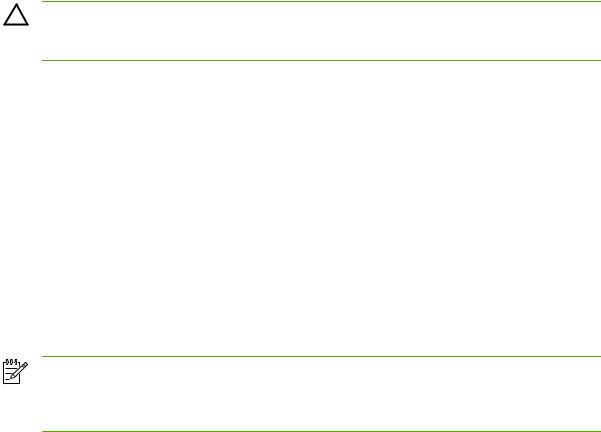
General guidelines
Some media might meet all of the guidelines in this manual and still not produce satisfactory results. This problem might be the result of improper handling, unacceptable temperature and humidity levels, or other variables over which Hewlett-Packard has no control.
Before purchasing large quantities of print media, always test a sample and make sure that the print media meets the requirements specified in this user guide and in the HP LaserJet Printer Family Print Media Guide, which you can view on the Web at www.hp.com/support/ljpaperguide. For ordering information, see Accessories and ordering information.
CAUTION Using media that does not meet HP specifications can cause problems for the device, requiring repair. This repair is not covered by the Hewlett-Packard warranty or service agreements.
The device accepts a variety of media, such as cut-sheet paper (including up to 100% recycled-fiber- content paper), envelopes, labels, transparencies, LaserJet glossy paper, HP LaserJet Tough paper, and custom-size paper. Properties such as weight, composition, grain, and moisture content are important factors that affect performance and output quality. Media that does not meet the guidelines outlined in this manual can cause the following problems:
●Poor print quality
●Increased jams
●Premature wear on the device, requiring repair
Choosing paper and other media
Properties such as weight, grain, and moisture content are important factors that affect performance and quality. To achieve the best possible print quality, only use high-quality media that is designed for laser printers. See Guidelines for using media for detailed paper and media specifications.
NOTE Always test a sample of the media before you purchase large quantities. Your media supplier should understand the requirements specified in the HP LaserJet Printer Family Print Media Guide (HP part number 5963-7863). See Guidelines for using media for more information.
HP media
HP recommends that you use HP LaserJet media in the device.
Media to avoid
The device can handle many types of media. Using media that is outside the specifications degrades print quality and increases the chance of jams occurring.
●Do not use media that is too rough.
●Do not use media that contains cutouts or perforations other than standard 3-hole punched paper.
●Do not use multipart forms.
●Do not use paper that contains a watermark if you are printing solid patterns.
14 Chapter 3 Media specifications |
ENWW |
Media that can damage the device
In rare circumstances media can damage the device. Avoid the following types of media to prevent possible damage:
●Do not use media with staples attached.
●Do not use transparencies designed for inkjet printers or other low-temperature printers. Use only transparencies that are specified for use with HP LaserJet printers.
●Do not use photo paper intended for inkjet printers.
●Do not use paper that is embossed or coated and is not designed for the temperature of the image-fuser. Select media that can tolerate temperatures of 200°C (392°F) for 0.1 second. HP manufactures a media that is designed for the device.
●Do not use letterhead paper that was produced with low-temperature dyes or thermography. Preprinted forms or letterhead must use inks that can tolerate temperatures of 200°C (392°F) for 0.1 second.
●Do not use any media that produces emissions, or that melts, offsets, or discolors when exposed to 200°C (392°F) for 0.1 second.
To order HP LaserJet printing supplies, go to www.hp.com/go/ljsupplies in the U.S. or to www.hp.com/ ghp/buyonline.html/ worldwide.
ENWW |
Choosing paper and other media 15 |

Guidelines for using media
The following sections provide guidelines and instructions for printing on transparencies, envelopes, and other special media. Guidelines and specifications are included to help you select media that optimizes print quality and avoid media that can cause jams or damage the device.
Paper
For best results, use conventional 80-g/m2 or 20-lb paper. Make sure that the paper is of good quality and free of cuts, nicks, tears, spots, loose particles, dust, wrinkles, voids, and curled or bent edges.
If you are unsure about what type of paper you are loading (such as bond or recycled), check the label on the package of paper.
Some paper causes print quality problems, jamming, or damage to the device.
Symptom |
Problem with paper |
Solution |
Poor print quality or toner adhesion |
Too moist, too rough, too smooth, or |
Problems with feeding |
embossed |
|
Try another kind of paper that has a smoothness rating of 100-250 Sheffield and has 4-6 % moisture content.
Check the device and make sure that the appropriate media type has been selected.
Dropouts, jamming, or curl |
Stored improperly |
Store paper flat in its moisture-proof |
|
|
wrapping. |
|
|
|
Increased gray background shading |
Might be too heavy |
Use lighter paper. |
Excessive curl |
Too moist, wrong grain direction, or |
Problems with feeding |
short-grain construction |
|
Use long-grain paper.
Check the device and make sure that the appropriate media type has been selected.
Jamming or damage to device |
Cutouts or perforations |
Do not use paper with cutouts or |
|
|
perforations. |
|
|
|
Problems with feeding |
Ragged edges |
Use good quality paper. |
|
|
|
NOTE The device uses heat and pressure to fuse toner to the paper. Make sure that any colored paper or preprinted forms use inks that are compatible with the fuser temperature of 200°C (392°F) for 0.1 second.
Do not use letterhead that is printed with low-temperature inks, such as those used in some types of thermography.
Do not use raised letterhead.
Do not use transparencies that are designed for inkjet printers or other low-temperature printers. Use only transparencies that are specified for use with HP LaserJet printers.
16 Chapter 3 Media specifications |
ENWW |
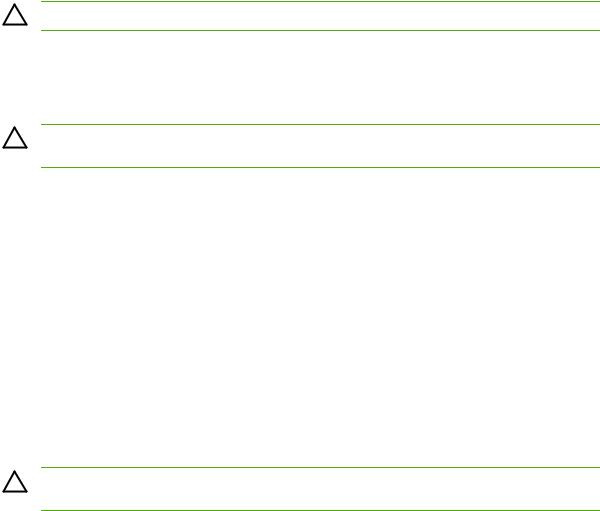
Colored paper
●Colored paper should be of the same high quality as white xerographic paper.
●Pigments used must be able to withstand the fuser temperature of 200°C (392°F) for 0.1 second without deterioration.
●Do not use paper with a colored coating that was added after the paper was produced.
Custom-size media
Use the main input tray for multiple sheets. See Supported media weights and sizes for the supported media sizes.
CAUTION Make sure that the sheets are not stuck together before you load them.
Labels
HP recommends that you print labels from the priority input tray. See Loading media for more information.
CAUTION Do not feed a sheet of labels through the device more than once. The adhesive degrades and might damage the device.
Label construction
When selecting labels, consider the quality of the following components:
●Adhesives: The adhesive material should be stable at 200°C (392°F), the maximum fuser temperature.
●Arrangement: Only use labels with no exposed backing between them. Labels can peel off sheets that have spaces between the labels, causing serious jams.
●Curl: Before printing, labels must lie flat with no more than 13 mm (0.5 inch) of curl in any direction.
●Condition: Do not use labels with wrinkles, bubbles, or other indications of separation.
Transparencies
Transparencies must be able to withstand 200°C (392°F), the maximum fuser temperature.
CAUTION You can print transparencies from the 150-sheet tray (tray 1). However, do not load more than 75 transparencies at one time into the tray.
ENWW |
Guidelines for using media 17 |
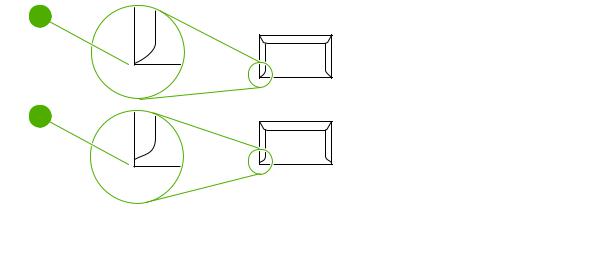
Envelopes
HP recommends that you print envelopes from the priority input tray. See Loading media for more information.
Envelope construction
Envelope construction is critical. Envelope fold lines can vary considerably, not only between manufacturers, but also within a box from the same manufacturer. Successful printing on envelopes depends upon the quality of the envelopes. When selecting envelopes, consider the following components:
●Weight: The weight of the envelope paper should not exceed 90 g/m2 (24 lb), or jamming might result.
●Construction: Before printing, envelopes should lie flat with less than 6 mm (0.25 inch) of curl, and should not contain air. Envelopes that trap air can cause problems. Do not use envelopes that contain clasps, snaps, tie strings, transparent windows, holes, perforations, cutouts, synthetic materials, stamping, or embossing. Do not use envelopes with adhesives that require pressure to seal them.
●Condition: Make sure that the envelopes are not wrinkled, nicked, or otherwise damaged. Make sure that the envelopes do not have any exposed adhesive.
Envelopes with double-side seams
An envelope with double-side-seam construction has vertical seams at both ends of the envelope rather than diagonal seams. This style might be more likely to wrinkle. Make sure that the seam extends all the way to the corner of the envelope as shown in the following illustration:
1
2
1 Acceptable envelope construction
Acceptable envelope construction
2 Unacceptable envelope construction
Unacceptable envelope construction
18 Chapter 3 Media specifications |
ENWW |

Envelopes with adhesive strips or flaps
Envelopes with a peel-off adhesive strip or with more than one flap that folds over to seal must use adhesives compatible with the heat and pressure in the device: 200°C (392°F). The extra flaps and strips might cause wrinkling, creasing, or jams.
Envelope storage
Proper storage of envelopes contributes to good print quality. You should store envelopes flat. If air is trapped in an envelope, creating an air bubble, the envelope might wrinkle during printing.
Card stock and heavy media
You can print many types of card stock from the input tray, including index cards and postcards. Some card stock performs better than others because its construction is better suited for feeding through a laser printer.
For optimum performance, do not use paper heavier than 157 g/m2 (42 lb). Paper that is too heavy might cause misfeeds, stacking problems, jams, poor toner fusing, poor print quality, or excessive mechanical wear.
NOTE You might be able to print on heavier paper if you do not fill the input tray to capacity and if you use paper with a smoothness rating of 100-180 Sheffield.
In either the software program or the printer driver, select Heavy (106 g/m2 to 163 g/m2; 28to 43-lb bond) or Cardstock (135 g/m2 to 216 g/m2; 50to 80-lb cover) as the media type, or print from a tray that is configured for heavy paper. Because this setting affects all print jobs, it is important to return the device back to its original settings after the job has printed.
Card stock construction
●Smoothness: 135-157 g/m2 (36-42 lb) card stock should have a smoothness rating of 100-180 Sheffield. 60-135 g/m2 (16-36 lb) card stock should have a smoothness rating of 100-250 Sheffield.
●Construction: Card stock should lie flat with less than 5 mm (0.2 inch) of curl.
●Condition: Make sure that the card stock is not wrinkled, nicked, or otherwise damaged.
Card stock guidelines
●Set margins at least 2 mm (0.08 inch) away from the edges.
●Use tray 1 for card stock (135 g/m2 to 216 g/m2; 50to 80-lb cover).
ENWW |
Guidelines for using media 19 |
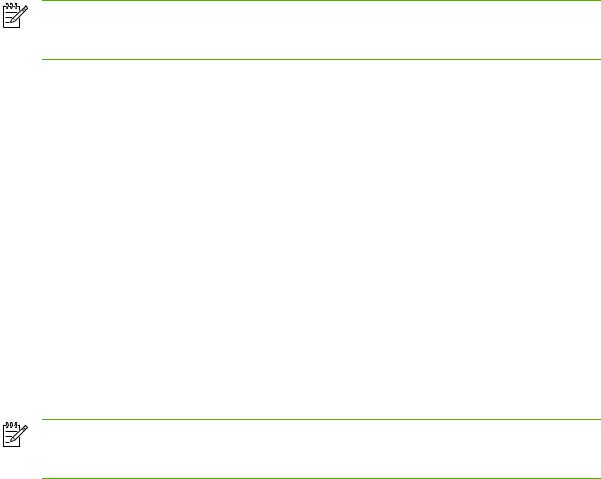
Letterhead and preprinted forms
Letterhead is premium paper that often has a watermark, sometimes uses cotton fiber, and is available in a wide range of colors and finishes with matching envelopes. Preprinted forms can be made of a broad spectrum of paper types ranging from recycled to premium.
Many manufacturers now design these grades of paper with properties optimized for laser printing and advertise the paper as laser compatible or laser guaranteed. Some of the rougher surface finishes, such as cockle, laid, or linen, might require the special fuser modes that are available on some printer models to achieve adequate toner adhesion.
NOTE Some page-to-page variation is normal when printing with laser printers. This variation cannot be observed when printing on plain paper. However, this variation is obvious when printing on preprinted forms because the lines and boxes are already placed on the page.
To avoid problems when using preprinted forms, embossed paper, and letterhead, observe the following guidelines:
●Avoid using low-temperature inks (the kind used with some types of thermography).
●Use preprinted forms and letterhead paper that have been printed by offset lithography or engraving.
●Use forms that have been created with heat-resistant inks that will not melt, vaporize, or release emissions when heated to 200°C (392°F) for 0.1 second. Typically, oxidation-set or oil-based inks meet this requirement.
●When the form is preprinted, be careful not to change the moisture content of the paper, and do not use materials that change the paper's electrical or handling properties. Seal the forms in moisture-proof wrap to prevent moisture changes during storage.
●Avoid processing preprinted forms that have a finish or coating.
●Avoid using heavily embossed or raised-letterhead papers.
●Avoid papers that have heavily textured surfaces.
●Avoid using offset powders or other materials that prevent printed forms from sticking together.
NOTE To print a single-page cover letter on letterhead, followed by a multiple-page document, feed the letterhead face up in the priority input tray, and load the standard paper in the main input tray (tray 1). The device automatically prints from the priority input tray first.
20 Chapter 3 Media specifications |
ENWW |
